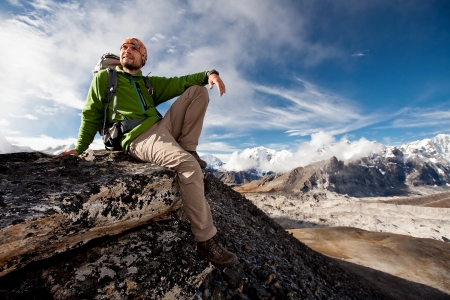1. Understanding the Demands of Hiking
Hiking in America is more than just a walk in the park—literally! The physical challenges you’ll encounter on U.S. trails are as diverse as the country’s landscapes, from the rocky paths of the Appalachian Trail to the steep switchbacks in Yosemite National Park. Knowing what your body is up against helps you train smarter and enjoy safer, injury-free adventures.
What Makes American Hiking Trails Unique?
Many American hiking spots present a mix of challenges that test your strength, balance, and endurance. Here’s what sets them apart:
Common Physical Challenges on U.S. Trails
| Challenge | Description | Where You’ll Find It |
|---|---|---|
| Uneven Terrain | Loose rocks, roots, and slippery mud make every step different, demanding constant balance and focus. | Rocky Mountains, Pacific Crest Trail |
| Elevation Gain | Long climbs put extra stress on your legs and lungs, especially at higher altitudes. | Sierra Nevada, Appalachian Trail |
| Unpredictable Weather | Weather can change fast—sunshine one minute, rain or snow the next—requiring adaptability and resilience. | Cascade Range, Grand Canyon |
| Distance & Duration | Hikes can last anywhere from an hour to several days, challenging your stamina and mental toughness. | Zion National Park, John Muir Trail |
The Physical Skills Needed for Injury-Free Hiking
- Balance: Navigating rocky or root-covered trails without twisting an ankle.
- Strength: Powering up steep climbs and stepping down safely on descents.
- Endurance: Keeping your energy up for long distances or back-to-back hiking days.
- Flexibility & Mobility: Handling big steps, crouching under branches, or scrambling over boulders.
- Adaptability: Adjusting to sudden changes in trail conditions or weather.
Tackling the Elements: Why Preparation Matters
No matter where you hike in the U.S., understanding these unique demands is the first step toward building a training plan that keeps you strong, steady, and ready for whatever nature throws your way. Each trail has its own personality—and so should your approach to getting hike-ready!
2. Building Cardiovascular and Muscular Endurance
Why Endurance Matters for Hikers
If you want to enjoy long, injury-free hikes across America’s diverse trails, building your cardiovascular and muscular endurance is key. U.S. hiking spots range from the rugged Rocky Mountains to rolling Appalachian hills, so it’s important to prepare your body for a variety of challenges. Good endurance helps you tackle steep ascents, rocky paths, and extended miles with confidence.
Effective Training Routines for Hikers
Incorporating the right exercises into your weekly routine can make all the difference. Here are some tried-and-true methods used by American hikers:
Trail Running
Trail running isn’t just for athletes—it’s a fantastic way to mimic the ups and downs of real hikes. Even short runs on local trails or parks help improve your heart health and leg strength.
Stair Climbing
No mountains nearby? No problem! Use a stairwell, stadium steps, or even a stair machine at the gym. Stair climbing builds strong glutes, quads, and calves while also boosting your cardio fitness.
Core-Strengthening Exercises
A strong core stabilizes your body over uneven ground and when carrying a backpack. Try planks, Russian twists, and mountain climbers to build core endurance.
Sample Weekly Training Plan
| Day | Main Activity | Focus Area |
|---|---|---|
| Monday | 30-minute trail run or jog on varied terrain | Cardio & Leg Strength |
| Tuesday | Stair climbing (20-30 minutes) | Leg Power & Endurance |
| Wednesday | Core workout (planks, twists, crunches) | Core Strength |
| Thursday | Rest or gentle stretching/yoga | Recovery & Flexibility |
| Friday | Interval training: brisk walk + sprints on flat or hilly ground (20 minutes) | Cardio & Speed Endurance |
| Saturday | Long hike or walk (aim for increasing mileage weekly) | Total Body Endurance |
| Sunday | Rest or active recovery (light biking or swimming) | Recovery & Mobility |
Tips for Success on American Trails
- Mimic Real Terrain: Choose training routes that reflect the types of trails you’ll be hiking—think elevation changes, dirt paths, and rocky surfaces.
- Add Weight Gradually: Practice with a loaded backpack as you get stronger to simulate actual hiking conditions.
- Pace Yourself: Consistency beats intensity. Start slow and increase difficulty as your endurance grows.
- Crosstrain: Mix in activities like cycling or swimming to keep things fun and avoid burnout.
- Stay Hydrated: Hydration is especially important in high-altitude U.S. regions like Colorado or Utah.
Tuning up your body with these routines will prepare you for everything from day trips in Yosemite to epic multi-day adventures along the Pacific Crest Trail. The more you train for real-world scenarios, the more enjoyable—and injury-free—your American hiking adventures will be!

3. Improving Mobility and Flexibility
Staying nimble on the trail isn’t just about strong legs—it’s also about having the mobility and flexibility to handle whatever the terrain throws at you. Whether you’re scrambling up rocky slopes or maneuvering tight switchbacks, better range of motion means fewer injuries and more fun. Here’s how you can boost your mobility and flexibility for hiking adventures in the great American outdoors.
Why Mobility and Flexibility Matter
Hiking often involves uneven ground, steep climbs, and quick changes in direction. If your joints and muscles are stiff, it’s easy to trip, twist an ankle, or strain a muscle. Good mobility keeps your movements smooth, while flexibility helps your muscles adapt to unpredictable surfaces. Both are key for preventing common trail mishaps.
Essential Stretches for Hikers
Try these simple stretches before and after hitting the trail to keep your body limber and ready:
| Stretch | Target Area | How To Do It |
|---|---|---|
| Standing Quad Stretch | Front of thigh | Stand tall, grab one ankle behind you, gently pull toward your glutes. Hold 20-30 seconds per leg. |
| Calf Stretch Against Wall | Calves/ankles | Place hands on wall, step one foot back, press heel down. Hold 20-30 seconds per side. |
| Lateral Lunge Stretch | Inner thighs/hips | Step wide, bend one knee, shift weight over bent leg. Keep other leg straight. Hold 20-30 seconds each side. |
| Seated Hamstring Stretch | Back of thigh | Sit with legs extended, reach toward toes keeping back straight. Hold 20-30 seconds. |
| Figure Four Hip Stretch | Hips/glutes | Sit or lie down, cross ankle over opposite knee, gently press down on raised knee. Hold 20-30 seconds per side. |
Mobility Drills for Trail Readiness
Add these drills to your warm-up or weekly routine to keep joints moving smoothly:
- Ankle Circles: Stand on one foot and rotate the other ankle in circles—10 times each direction per foot.
- Knee Hugs: Pull one knee toward your chest while standing; alternate sides for 10 reps each.
- Lunges with Rotation: Step forward into a lunge, then twist your upper body toward your front leg; repeat for 8 reps per side.
- Hip Openers: March in place while lifting knees high and circling them outward—10 reps per leg.
- Cow-Cat Stretch (Spinal Mobility): On hands and knees, alternate arching and rounding your back—10 cycles total.
Tips for Staying Consistent
The best way to improve is by making these stretches and drills a habit. Try adding them to your morning routine or as part of your pre-hike warm-up. Remember: even five minutes a day makes a difference on the trail!
4. Injury Prevention Practices
Warm Up Like a Pro
Before hitting the trail, American hiking experts always recommend taking time to warm up your muscles and joints. Warming up increases blood flow, prepares your body for activity, and helps prevent sudden strains or pulls. Try these simple warm-up moves:
| Exercise | Description |
|---|---|
| Leg Swings | Swing each leg forward and backward 10-15 times to loosen hips and hamstrings. |
| Arm Circles | Make big circles with your arms to get shoulders ready for carrying a pack. |
| Ankle Rolls | Roll each ankle in both directions for 20 seconds to prep for uneven ground. |
Don’t Skip Your Cool-Down
After your hike, a cool-down routine can help your body recover and reduce stiffness. This doesn’t need to be complicated—spend 5-10 minutes stretching major muscle groups like calves, quads, hamstrings, and back. Focus on gentle stretches and slow breathing to relax tight areas after a long trek.
Sample Cool-Down Stretches
- Calf stretch against a rock or tree
- Standing quad stretch (hold onto your backpack for balance)
- Gentle forward fold for the hamstrings and lower back
Gear Check: Your First Line of Defense
In the U.S., experienced hikers know that small gear issues can lead to big problems on the trail. Getting into the habit of regularly checking your equipment helps prevent blisters, sprained ankles, and overuse injuries.
Pre-Hike Gear Checklist
| Item | What to Check |
|---|---|
| Hiking Boots/Shoes | No worn-out soles; secure laces; proper fit to avoid blisters. |
| Socks | No holes or bunching; use moisture-wicking materials. |
| Packs & Straps | No tears; straps adjusted snugly but comfortably. |
| Trekking Poles (if used) | Tight locks; tips intact; wrist straps secure. |
Stay Consistent with Injury Prevention Habits
The best way to stay injury-free is to make these practices part of your regular hiking routine. Just a few extra minutes before and after each hike—and a quick gear check—can mean more adventures with less downtime from injuries.
5. Planning and Progression Strategies
Set Realistic Hiking Goals
Before you lace up your boots, it’s important to know where you’re headed—both literally and in your training plan. Start by identifying the type of hikes you want to tackle, whether its weekend strolls on local trails, or challenging treks through iconic U.S. landscapes like the Rockies or the Appalachian Trail. Think about distance, elevation gain, and how many hours you want to spend on your feet. Set goals that match your current fitness level and lifestyle, then build from there.
Progressively Increase Mileage and Difficulty
One of the best ways to avoid injuries is to gradually increase your hiking load. A smart rule of thumb: boost your weekly hiking mileage by no more than 10% at a time. This gives your muscles, joints, and tendons time to adapt without feeling overwhelmed.
| Week | Total Weekly Mileage | Elevation Gain (ft) | Suggested Trail Type |
|---|---|---|---|
| 1 | 6 miles | 500 | Local park trails |
| 2 | 7 miles | 750 | Urban greenways with hills |
| 3 | 8 miles | 1000 | Larger state park trail loops |
| 4 | 9 miles | 1200+ | Mountainous terrain practice hikes |
Mix It Up for American Trails
The U.S. is home to diverse trail conditions—from the rocky paths of Colorado to the muddy slopes of Vermont. Adapt your training to mimic real trail experiences:
- The Rockies: Focus on elevation gain with stair climbing or hill repeats; carry a loaded daypack for extra challenge.
- The Appalachians: Practice on uneven ground, add balance drills, and get used to roots and rocks underfoot.
- The Pacific Northwest: Train in wet conditions if possible; wear waterproof gear and hike in drizzle to prep for rain-soaked adventures.
- The Southwest: Build heat tolerance with midday walks (always bring water!), and strengthen ankles for loose gravel.
Tweak Your Plan as You Go
If you experience soreness or fatigue beyond normal, pause and repeat the previous week’s routine before moving forward. Listen to your body—progress isn’t always linear, but consistency is key.


